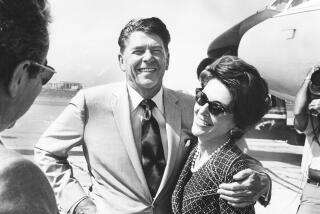The Wealth Effect
WASHINGTON — WASHINGTON -- The new wealth map of the United States, powerfully redrawn over the last two decades, shows California moving ahead, Texas trying to pass the Golden State and New York losing its once great lead. Doubly significant is that state and national politics are beginning to pick up the tensions created by this wealth shift.
Tremors are already evident in the 2002 elections. The Texas-run Bush White House, out to neutralize California by getting a GOP governor elected so that Democrats can’t take the state for granted in the 2004 presidential race, has wound up with a miscast Republican nominee of a sort never expected. He’s Bill Simon Jr., an archconservative financier with Texas connections and ties to both Enron wheeling and dealing and the religious right. That’s double trouble, because Texas and California, which three decades ago shared a Sun Belt conservative trend, are now emerging at polar ends of a new cultural economics.
California has the early 21st century edge in wealth. Despite the Nasdaq nosedive and high-tech trauma, the 2001 ranking of the 400 richest Americans had California in the top spot with 92, New York next with 49 and Texas third with 36. First-quarter venture-capital data also showed California remaining well ahead of the other two states.
Part of California’s economic advantage is that the state is the major U.S. Pacific Rim window on the emerging economic and technological powerhouses of Asia. As for its cultural economics, California’s major fortunes are tied to the sort of wealth that seemingly represents the future: computer networks, biotechnology, nanometrics, electronic and video entertainment and other intellectual property.
This is where the new map gets interesting. The first stage of California’s modern economic rise came in the 1940s through the 1960s, when the Sun Belt phenomenon touched Florida, California and Texas in substantially similar ways. All three major Sun Belt states experienced huge growth and conservative political trends tied to the economics of retirement, suburbia, agribusiness and aerospace.
In the early 1980s, Texas briefly dominated the upper reaches of the lists of the richest Americans because of the oil money of the Hunt, Bass and Cullen families. But California has the most important new mega-vehicle: high technology, which it rode into a new era, passing New York in the wealth lists during the 1990s.
In terms of population, the 21st century began with California No.1, Texas No. 2 and New York No.3. More important, though, California is the liberal U.S. capital of high technology and entertainment, Texas the conservative capital of oil and energy, and New York the liberal capital of U.S. finance and communications--and their various rivalries mix politics and economics.
New York, with its comparative population already slipping, is dependent on finance and communications rooted in 20th century prestige and technology. The giant media, symbolized by the great TV networks and news weeklies anointed during the 1940s, 1950s and 1960s, are vulnerable to the new economic diversity. Finance has become New York City’s bread and butter. In 1998, H. Carl McCall, the New York state comptroller, issued an analysis contending that 56% of the city’s total income growth since 1992 was provided by securities firms. If the first decade of this century turns out to be one of stagnant markets, disillusionment with finance and mild re-regulation, the feeding trough profiled by McCall will dry up considerably.
Texas is the energy capital that would also like to be the unofficial national political capital. Since 1980, each Republican administration has had a Texan as either president or vice president. Absent Watergate, President Richard M. Nixon was grooming former Texas Gov. John Connally to succeed him, and the Texas reign, consummated by Bush I and Bush II, would have started even earlier. Texas is also the buckle on the GOP Bible Belt coalition, as well as a major linchpin of the now increasingly Southern-centered U.S. defense-industry and military-base axis.
Like oil and water, Texas and California mix less and less well. To an extent, the minority culture in one is the majority in the other. The most Democratic part of affluent Texas is the academic, governmental and high-tech district around Austin, while the most Republican parts of California are focused on banking, agribusiness, oil and the military. Some analysts have even seen a parallel in the 2000-2002 stock market, where the oil and high-tech sectors often move contrarily.
The political rivalry is also getting serious. When the new Republican presidential cycle started in 1968, California was the GOP pivot. Every Republican administration elected between 1968 and 1984 had a Californian as president. In 1988, the baton passed. California is becoming the Republican Yesterday, the big state where Democratic presidents now win almost without campaigning. Texas is the Republican Today, the one big state where a GOP presidential victory is virtually a given.
Which is where the 2002 Republican stratagem-turned-possible-disaster comes in. Elect a GOP governor of California, Bush strategists hoped, and the Golden State would become competitive enough that local Democrats would have to fight for their 2004 presidential nominee. California money could not go to help in marginal states.
However, instead of Richard Riordan, the moderate mayor of Los Angeles and choice of the White House, GOP primary voters went for Simon, a conservative with a resume heavy on Houston-style finance and fundamentalism. Simon exudes the wrong images and issues--his deal-maker’s preoccupation with cutting the capital gains tax, his anti-abortion stance better suited to Amarillo than Alhambra or Anaheim, and even a tie to Enron, the malevolent Houston energy peddler that electricity-sensitive Californians love to hate.
As Enron’s trading techniques and off-books partnership arrangements come out in courts and other hearings, it’s going to be a problem. Not only did Simon, in 1995, reportedly arrange a big Enron investment in Houston-based Hanover Compressor, a company he founded, but the money came through Joint Energy Development Investments (JEDI), one of the Enron partnerships at the center of the federal investigation into Enron’s collapse. (Last week, Simon denied financial involvement with Enron and said he had not helped to land the loan while serving as a Hanover board member.)
Simon also reportedly worked with Enron and JEDI in landing Hanover a role in a Venezuelan joint venture. Several years earlier, an energy company run by George W. Bush partnered with Enron Oil and Gas in a well outside Midland, Texas. This duality could give the White House a new threat--a political Return of the JEDI?--in this year’s California gubernatorial combat.
Not that California can sit back and count on 21st century trends to consolidate its political and economic primacy and bolster its wealth-holders. The rules are changing. Fifty or sixty years ago, from Mare Island to San Diego, California was the principal beneficiary of U.S. war mobilization. Now more of the military infrastructure is in the South, and any major war triggered by the Middle East conflict or a U.S. attack on Iraq could jeopardize more Golden State international interests than it rewards.
As for the political interests of high tech and entertainment, intellectual property and its protection seem less of a focus in the Bush administration than in Bill Clinton’s. Another question mark for California business has to do with technology transfer. The huge numbers of East Asian and Indian engineers and executives in California high-tech companies raise the prospect that, over the next several decades, hundreds of thousands will take their skills and investments back home and use them to grow what could, by 2030 or 2040, be an increasingly Asian-dominated global technology economy. Kindred technology transfer--it can come quickly--helped shift the global technological lead from Britain to Germany and the United States between 1890 and 1914.
Trade itself is a question mark. California’s biggest exports are technology and entertainment, but in the first nine months of 2001, White House policy, under the lead of U.S. Trade Representative Robert Zoellick, a former Enron consultant, increasingly emphasized expanding the world trade agenda to include energy and water services. Those ambitions were especially important to Enron and Texas-based Halliburton, the company formerly run by Vice President Dick Cheney. Technology isn’t likely to be a White House priority when its staff members come from the energy business.
In California and elsewhere, there is little static about U.S. wealth. But since the American Revolution, the use of politics and government has been central to who gets what and how. Anyone thus concerned with the names and sectors of the wealthiest Americans has to keep almost as close an eye on the California-Texas-New York political alignments as on the annual Top 400 lists.
More to Read
Inside the business of entertainment
The Wide Shot brings you news, analysis and insights on everything from streaming wars to production — and what it all means for the future.
You may occasionally receive promotional content from the Los Angeles Times.










